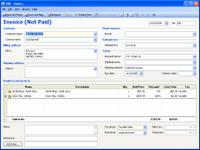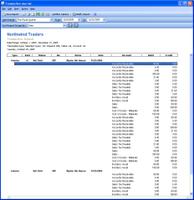Using the Transaction Journal report to track changes to an invoice
One of the key features in Small Business Accounting is the ability to see evolutions of a posted document over time, like an Invoice. Most products have a transaction journal report, but they only include the "current state" of the document. That is to say, it shows what accounts have been posted to and for what amount. The transaction journal report in SBA acts a little more like an audit trail, so if an invoice changes, the transaction journal report shows each of the
 different versions of the invoice as voided documents as well as the current invoice. As an example: Lets assume that I create an invoice for a customer with two items that I stock in inventory. I finalize the sale and post the invoice. Now, lets assume that before I recieve payment for the invoice, someone who has access to AR changes the invoice such that the most expensive item on the invoice has a 100% discount -- effectively giving the item away for free. There is the potential here for receiving a payment for the invoice of the lower amount and being shortchanged.
different versions of the invoice as voided documents as well as the current invoice. As an example: Lets assume that I create an invoice for a customer with two items that I stock in inventory. I finalize the sale and post the invoice. Now, lets assume that before I recieve payment for the invoice, someone who has access to AR changes the invoice such that the most expensive item on the invoice has a 100% discount -- effectively giving the item away for free. There is the potential here for receiving a payment for the invoice of the lower amount and being shortchanged.
Using the transaction journal report, we see both of these invoices (one as voided and the latest one). By comparing the two, I can see what has changed, including which accounts were affected in one vs the other. To change it back, drill down on the current invoice, Edit the invoice and make the appropriate changes. Also, note that this is not a substitute for the Change Log report, it's only more detailed. My recommendation is to use the Change Log report on a regular basis to determine what things are being updated in your books and use the transaction journal report to probe deeper on suspicious updates to transactions.
A couple of tips:
- Using the transaction journal link on the Actions menu seems to be "auto-filtered" to the invoice you are looking at. It doesn't appear to take other filtering options well. In light of this, launch the transaction journal report from the reporting area and filter from there.
- Best filter to apply is the combination of A) document number and B) document type (e.g., 1000 and Invoice)

3 Comments:
Like you, I have also been an SBA user since the beta began last year.
I like reading reading your blog and think that you have something of value to share.
Unfortunately, it appears that all you are posting are the headers to each post so that anyone interested in reading your blog has to return to blog page to read the full post. While I respect your right to manage your blog in any manner you see fit, I don't see any benefit to you from requiring readers to do this.
Please consider posting your full posts.
Thanks for the kind words. I am probably not as blog savvy as I should be. I checked around the options for publishing in blogspot and didn't see an option for publishing beyond what I am today. If anyone knows of an option I need to enable, I am open to it.
get your Sage MAS 90 support at http://www.mtsisolutions.com/support/mas-90-support.shtml
Sage MAS 90 is the best accounting software for small to midsize businesses.
Post a Comment
<< Home